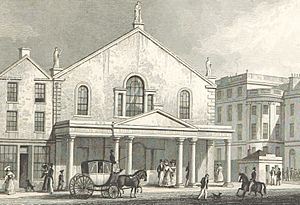David Ross (actor, born 1728) facts for kids
David Ross (born May 1, 1728 – died September 14, 1790) was a famous British actor and theatre owner. He started his acting career in Dublin, then became well-known in London, performing at important theatres like Drury Lane and Covent Garden. He also went to Edinburgh, where he became an actor-manager and even built his own theatre.
Contents
Early Life and Acting Start
David Ross was born in London. His father was a lawyer from Edinburgh who moved to London. David went to Westminster School. When he was thirteen, something happened that made his father upset, and they never got along again. His father even left instructions in his will for David to receive only one shilling each year. In 1769, David challenged this will and eventually won nearly £6,000. We don't know how he supported himself before this.
In May 1749, David Ross began his acting career in Dublin at the Smock Alley Theatre. He played a character named Clerimont in a play called The Miser. He stayed in Dublin for two more years.
Becoming a London Star
Later, David Ross was hired by the famous actor David Garrick. In October 1751, he made his first appearance in London at the Theatre Royal, Drury Lane. He played Young Bevil in The Conscious Lovers. People really liked his performance. One writer said he was "pleasing" and "natural," and that he could bring back the "real fine gentleman" character to the stage. He quickly became popular.
In 1753, he played the main character in Oroonoko. In 1754, he was the first actor to play Icilius in a new play called Virginia.
On October 3, 1757, David Ross performed for the first time at Covent Garden. He played Essex in The Earl of Essex, which was one of his favorite roles. He stayed at Covent Garden until 1767. During this time, he played many important characters in both serious plays (tragedies) and funny plays (comedies).
Building a Theatre in Edinburgh
After the 1766–67 season, David Ross left Covent Garden and moved to Edinburgh. In 1767, after a lot of public discussion and some strong disagreement, a special license was given for a patent theatre in Edinburgh. This was a big deal because it was the first theatre in Scotland that was officially allowed to operate.
The theatre cost £2,500 to build. This money was raised by 25 people who each paid £100. These investors received a small part of the theatre's profits and could watch all performances for free. Ticket prices ranged from 1 shilling to 4 shillings. The total cost, including everything inside, was £5,000 when it opened in December 1769. A full theatre could earn about £140 per night.
David Ross wanted to be the manager of this new theatre. Even though people in Edinburgh didn't know him well, he was given the theatre in the autumn of 1767. He reportedly paid £400 a year to rent it. Some people didn't think he was the right person to manage it, which caused some arguments.
Opening the Theatres
Despite the challenges, David Ross opened the "old" theatre in the Canongate on December 9, 1767. He performed as Essex in The Earl of Essex. This was a very important moment because it was the first play legally performed in Scotland.
Two years later, on December 9, 1769, he opened a brand new theatre in Edinburgh called the Theatre Royal. He had managed to get the building constructed with help from subscriptions, but he didn't have enough money to run it well. After a difficult first season, he rented the theatre to Samuel Foote for 500 guineas a year and went back to London. Later, other managers took over and made the theatre more successful.
The second season began on November 17, 1770, with Ross's own play, "The Commissary." A few days later, they put on "The Mirror," which made fun of a famous preacher.
The theatre's location became much better when the North Bridge was finished. This bridge connected the theatre to the main part of the city. However, the North Bridge collapsed in August 1769, just before the new theatre opened. This made it very hard for people to get to the theatre. The bridge wasn't reopened until 1772.
In 1781, a man named John Jackson bought the Theatre Royal. He later wrote a book about the history of Scottish theatre.
Return to London and Later Life
In October 1770, David Ross returned to Covent Garden in London. He again played Essex, and it was announced as his first performance there in four years. He quickly went back to playing his old, well-known characters. After a couple of seasons, his name appeared less often on the theatre programs.
After the 1777–78 season, he had a bad accident and broke his leg. He never performed on stage again after that. For some years, he was very poor. However, an unknown friend, who was later found to be Admiral Samuel Barrington, gave him £60 every year. This gift continued until David Ross died.
David Ross passed away in London on September 14, 1790. He was buried three days later at St James's Church, Piccadilly. The famous writer James Boswell was one of the main people attending his funeral.


